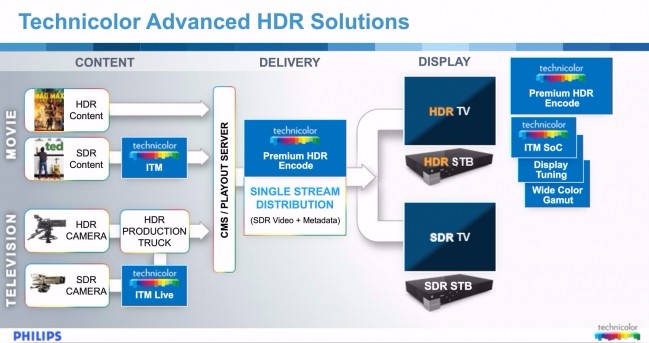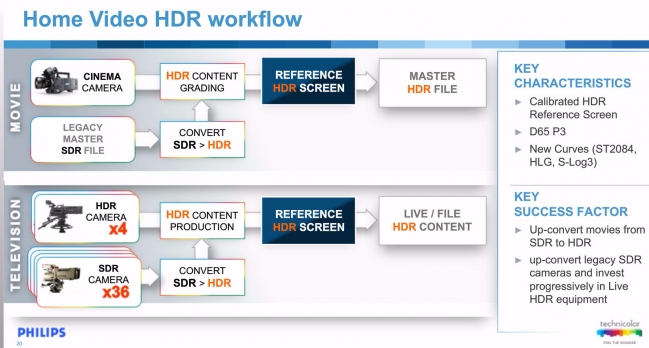HDR content for consumers has so far consisted of a few movies and episodic TV content specifically mastered for HDR and delivered over a small number of OTT services and via the newly released Ultra HD Blu-ray format. But more HDR content delivered via conventional video delivery platforms is coming quickly as Technicolor and Vubiquity have now teamed up to accelerate this process. It might even mean the potential for the first HDR channel to surface in 2016.

The two issued a press release yesterday on their plans and I also listened to a webinar presented by Technicolor and Philips about their combined HDR technologies and delivery platforms. Technicolor and Philips joined forces earlier this year consolidating their competitive approaches into a unified solution.
According to the Vibiquity web site, the company “connects content owners and video providers to deliver entertainment to viewers on any screen. Working with over 600 leading film studios, television networks, independent producers and MCNs, Vubiquity brings premium content to over 750 global video distributors.” The new agreement with Technicolor will create what they call an “in-network” HDR up-conversion and delivery service, meaning content owners can leverage the Technicolor HDR tools on the Vubiquity platform.
The result will be the ability to enable any network to offer consumers both live linear programming and video-on-demand (VOD) in HDR. What networks do with this capability is yet to be seen, but an HDR channel is not too big a leap.
Specifically, Vubiqity will integrate Technicolor’s HDR Intelligent Tone Management (ITM) solution which allows programmers to “up-convert” existing Standard Dynamic Range (SDR) content to HDR. In addition, it will integrate the Philips/Technicolor HDR distribution technology.
In the webinar, Technicolor’s Josh Limor and Philips’ Frederic Guillanneuf provided some background on HDR and UHD and then described how their solution integrates into the movie and TV production workflows. As shown in the graphic below, new movies can be mastered in HDR, but there is a huge need to convert the library of SDR content to HDR. This can be done in an offline “upconversion” process.
In television, production is going to include a mix of HDR and SDR cameras, so you need a way to create HDR content from the SDR cameras in real time. In TV production, the wide dynamic range of the camera is compressed at the camera to an SDR range so real time upconversion is needed in this workflow as well. Both workflows lead to the mastering and a review of content in an HDR format. The key pieces of technology provided by Technicolor are their Intelligent Tone Mapping algorithms that do the SDR-to-HDR upconversion
Having an HDR master is great, but how do you this will not play on legacy devices. To solve this, the team uses a single stream approach for distribution. This consists of an SDR master plus metadata. This encoding can be done at a video distribution facility and uses algorithms to do the HDR-to-SDR conversion adding metadata about how this process was done. This metadata is added to the distribution stream, but will be ignored by SDR devices like set top boxes and TVs, which simply play the SDR content. But an HDR device with the proper decoder, can now read and use the metadata to recreate the HDR signal.
Technicolor likes to call this ‘guided upconversion’ as it is supplying the metadata to create an upconverted signal that is tailored to the capabilities of the particular playback device.
This approach requires that the playback devices have an SoC with the Technicolor/Philips decoder. The good news is that a number of silicon TV SoC providers have or will integrate this functionality, so TVs and Set Top Boxes with the decoders will be available in 2016.
In addition, network operators have the ability to deliver the HDR signal directly to consumers in the HDR10 format via OTT platforms.
Many will argue that the quality of upconverted HDR is inferior to natively mastered HDR. While this is true, it is a matter of degree. The algorithms developed by Technicolor are based upon comparing how a colorists graded the HDR and SDFR versions of the same content and noting where there were differences. When we discussed the process with Technicolor at CES 2016, they noted that perhaps 70-80% of the changes were predictable and therefore can work well in an automated algorithm. As a result, some scenes will auto convert quite well and others might justify some human intervention – which may or may not happen. The debate is similar to resolution upscaling and 2D-to-3D conversion. Inexpensive and basic approaches have their flaws while sophisticated approaches are quite good.
A commercial launch of this new HDR service is expected later in 2016. Technicolor and Vubiquity, which is headed by former Warner Bros. executive Darcy Antonellis, will be demonstrating the new capabilities in a live broadcast that simulates a channel primetime broadcast at NAB 2016 – and I will be there to check it out. – CC



